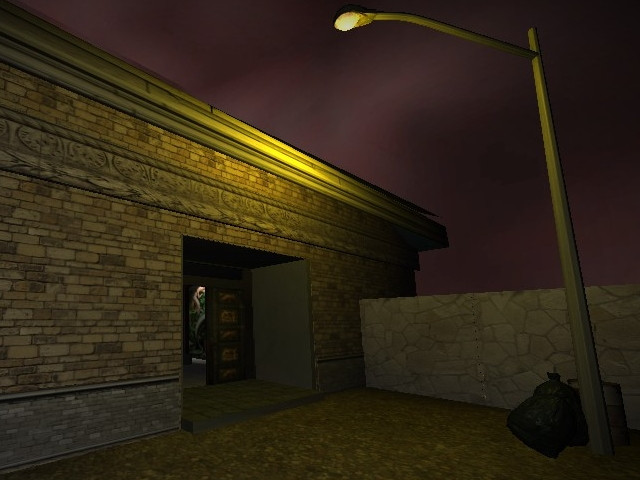Reptile Zoo Lore-
Here's a bit of semi-official back story or "lore" for the video game that we are currently developing, Reptile Zoo: The Sinister Mutation. The text below should be read as sort of a parody of a brochure or website or other piece of promotional material for the fictional "Reptile Zoo" that is featured in the game. The game itself will be straight horror, but I decided to make this text somewhat darkly humorous as well as disturbing, because I enjoy that kind of writing and it's in keeping with Twisted Jenius's style to inject a bit of fun into these things. I'm also including a couple of new screen shots below, in order to keep you updated on our progress. Let us know what you think!
Welcome to Reptile Zoo!
Come let your blood run cold at Reptile Zoo, recently voted Texas' 183rd must-see attraction by an unspecified Internet publication!
Our history-
What would become Reptile Zoo originally began in 1933 when traveling showman W.C. "Bill" Bevan arrived in town and began displaying recently caught rattlesnakes to the general public, thrilling old and young alike with his family attraction of venomous serpents housed in a quickly constructed and ultimately unstable structure made of wood planks, barbed wire, and old sheet metal. Many children were killed.
Seeking to create a better established place of business, Bevan petitioned the city for financial help in creating his visionary idea for a permanent "Reptile Farm". The Reptile Farm proposal was quickly dismissed by city officials, but was later approved under the new name of "The Reptile Garden and Research Bureau". The city donated an abandoned rock quarry to the project, which had been permanently evacuated years earlier due to mass mercury contamination. The substance can still be found on the site to this day.

Prison labor was used to construct the stone structures and paddocks out of the natural building materials left behind from the quarry, and many of these original buildings and walls still grace the grounds of Reptile Zoo. Mayor Brackenridge hailed the Reptile Garden to be an astounding success. Cited as being the first such facility in the United States, within a week it had paid for itself in attendance revenue, having made back the $15 investment, along with the free convict labor and free materials that the city had put into it. The Garden single-handedly sustained the entire region through tourist dollars, until the end of the Depression.
In 1938, Joe "Butcher of Elmendorf" Ball was accused of killing over twenty people and feeding their remains to the alligators that he kept in a pit behind his saloon. When the sheriff's deputies came to his business to question him, he shot himself in the head and therefore was unavailable for comment. However, his man-eating alligators were eventually shipped off to the next county and lived out the rest of their lives as residents of the Reptile Zoo. The descendants of Ball's hungry pets can still be seen in our exhibits.
After the war, the zoo got an even greater influx of new animals including turtles and exotic lizards. Many were donated from various organizations and law enforcement agencies who didn't know what else to do with them. Among these were a group of rabid iguanas carrying a new strain of the Kothoga virus, which were confiscated after being illegally smuggled in a banana crate from South America.
In the early 1970s, newly formed DARPA was engaged in genetically modifying jungle vipers to sniff out and attack enemy guerrillas hiding in tropical environments. The snakes proved too unpredictable and too lethal to use in any sort of practical military situation and so the remaining batches of these deadly "ultra-snakes" were remanded to Reptile Zoo, where they became a permanent part of the collection. It was also around this time that the park officially changed its name to Reptile Zoo.
In 1981, then owner George Kimbrell retired and sold the facility to a shadowy investment firm who would prefer to remain anonymous. It was four years later, in 1985, that the latest renovations to some of the buildings in the park were completed.
Today-
We are proud to say that Reptile Zoo currently houses one of the most unique collections of creatures in the world, thanks in no small part to various genetic experiments, generations of inbreeding and dubious levels of mercury in the water. Not only do our animals defy the laws of god and nature, but also several state and federal ones as well.
We continue to confidently move forward, always working to uphold our animal collection's founding motto- "if it dies, just buy a new one", as we precariously straddle the line between reputable zoological organization and roadside carnival freak show. And while much of the facility may have fallen into disrepair during the last several decades, we are still "technically" open for business and our small, underpaid but committed staff of "professionals" work diligently to ensure the public's safety by keeping all of the various monstrosities from leaving the grounds and running amok on an unsuspecting world. But they could sure use your help. So why not reward their efforts by stopping by and perhaps even donating a little bit or buying a souvenir t-shirt; thus keeping the doors open and the lights on for another day.
It's educational fun for the whole family and we're conveniently located on an undisclosed back road of the Lone Star State. So come on down to Reptile Zoo and see what all the screamin's about!
- False Prophet
